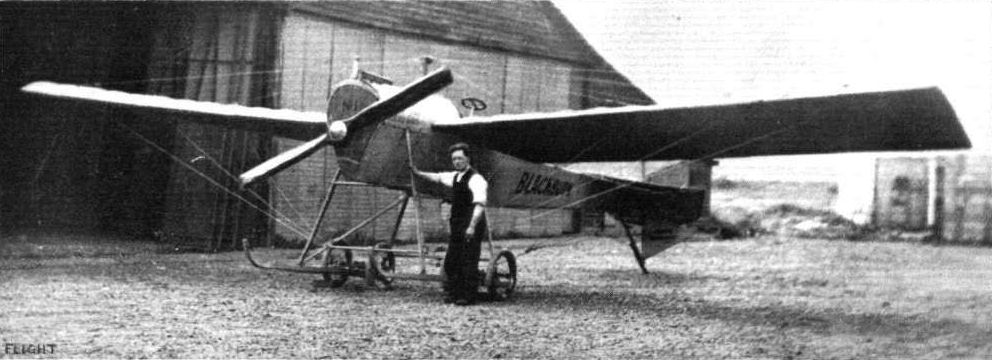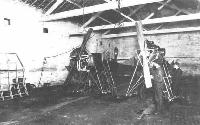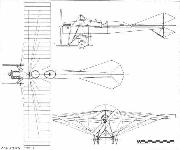A.Jackson Blackburn Aircraft since 1909 (Putnam)
Blackburn Type E
During 1911 the efforts of Robert Blackburn and other British pioneers produced a number of sturdy aeroplanes with good flying characteristics which challenged the supremacy of French machines to the point where the placing of military contracts for British-built aircraft could not long be delayed. As expected, the War Office issued its first military aircraft specification in November that year and called for a reconnaissance two-seater able to carry a useful load of 350 lb over and above essential equipment and to have an initial rate of climb of 200 ft min, 4 1/2 hr endurance, 55 mph maximum speed and able to maintain 4,500 ft for 1 hr. It also had to be transportable in a crate from one operational area to another. Competing firms were given just nine months in which to design, build and test before the commencement of competitive trials on Salisbury Plain in August 1912.
To meet these requirements Robert Blackburn designed a two-seat 'military' aeroplane in metal which retained most of the principal features of his successful Mercury series. The mainplane was built up from two 18 swg tubular-steel spars, respectively 2 in and 1/2 in in diameter, with ribs of 1/4 in cottonwood fretted out for lightness and edged with 1 in by 1/4 in ash. A number of light ash strips ran transversely and the leading and trailing edges were reinforced with the same material. The tubular spars were filled at the root ends and securely bolted to steel plates through which passed the stout kingpost carrying the wing warping and bracing wires.
For durability and to expedite repairs, the triangular fuselage had 32 detachable and interchangeable vertical struts and 58 cross-members, all of oval-section steel tubing, joined by specially riveted clips and covered with sheet aluminium. The tail unit was formed from fabric stretched over a steel-tube framework and ending in an ash trailing edge to which were hinged steel rods carrying the elevator and twin triangular rudders. Control wires ran inside the fuselage, and the much simplified, twin-skid, four-wheeled undercarriage was of oval steel tubing and incorporated built-in anchorages for the flying wires.
The new monoplane was built in the Balm Road works alongside a singleseater (also with steel-tube fuselage) ordered by Lt W. Lawrence for use in India where he had seen Army service the year before. Both monoplanes consequently earned a place in aviation history as the first aircraft of British design and construction to have metal fuselages. Powered by a 60 hp Green four-cylinder inline water-cooled engine and closely resembling the Blackburn Type B, Lawrence's single-seater was taken to Filey for test in April 1912 and took off in 30 yards with fuel for four hours at approximately the same all-up weight as a standard wooden Mercury. Painted grey overall and bearing the inscription Indian Aviation Co Ltd on the lower rudder, the name L'Oiseau Gris on the engine cowling and with No. 1 painted on the radiator grill, it went to Brooklands for further trials in the following month. Although entered by the owner in the round-London Aerial Derby of 8 June 1912, the aircraft was scratched as 'not ready in time'. As this occurred some two months after the first flights at Filey, teething troubles are suggested which may have been the result of using an engine which required a heavy water cooling system and the reason for the end of Lawrence's interest in it.
Trouble of this sort was avoided in the military two-seater which appeared later in June 1912 fitted with a vee-8 air-cooled 70 hp Renault. It differed from the first in having a curved top decking, which extended as far aft as the forward tip of the dorsal fin, to accommodate the crew in tandem cockpits with the pilot and his triple control unit in the rear. Extra fuel, increasing the endurance to five hours, was carried in a cigar-shaped tank between the undercarriage struts and, following the precedent set by the Blackburn Type B trainer, the little triangular rudders bore the designation Type E.
An early intention was for the Eastchurch pilots, Lt Spenser Grey, RN, and Capt R. Gordon, RMLI, to pilot these machines in the British Military Aeroplane Trials, but when the two-seater was taken to Knavesmire, York, for flight testing by Robert's brother Norman Blackburn and R. W. Kenworthy it proved too heavy to leave the ground and in fact never did so. It was taken back to the Balm Road works, and when the entry lists for the Trials were published in July 1912 Blackburn was not represented. The ultimate fate of the 'all-steel' monoplanes is uncertain but later on, in the winter of 1912, the two-seater appeared briefly on the playing fields of Cockburn High School off Dewsbury Road, Leeds, with Spenser Grey and Gordon in attendance.
A further development of the type was evidently contemplated since the company records refer to an undesignated two-seat military aircraft of 1912-13 with a specification which docs not correspond to that of the Type E.
SPECIFICATION AND DATA
Manufacturers: The Blackburn Aeroplane Co, Balm Road, Leeds, Yorks.
Power Plants:
(Single-seater) One 60 hp Green
(Type E Two-seater; One 70 hp Renault
Dimensions:
(Type E)
Span 38 ft 4 in Length 31 ft 2 in
Wing area 290 sq ft
(Project)
Span 40 ft 0 in Length 32 ft 0 in
Wing area 276 sq ft
Weights: (Type E) All-up weight 950 lb
Performance: (Type E) Maximum speed 80 mph (Project) 65 mph
Endurance: (Single-seater) 4 hr (Type E) 5 hr (Project) 5 hr
Production: Two dissimilar aircraft only:
1. Single-seater No. 1 L'Oiseau Gris, 60 hp Green, first flown at Filey April 1912, to Brooklands May 1912.
2. Two-seater military Type E, 70 hp Renault, completed June 1912, never flew.
M.Goodall, A.Tagg British Aircraft before the Great War (Schiffer)
Deleted by request of (c)Schiffer Publishing
BLACKBURN Type E monoplane
This type was designed to meet the first official British specification for a military reconnaissance two-seater. The basic structure was of steel tube and the fuselage was covered with aluminum panels. The tail surfaces were mainly of light steel tube with fabric covering. The warping wings were constructed on two tubular steel spars, as for the Mercury III.
The first machine was built as a single-seater to a private order. The second of the two machines had a fairing behind the pilot which continued down to the dorsal fin and an extra streamlined fuel tank between the undercarriage struts. A developed version remained as a project only.
No.1 60hp Green four-cylinder inline water-cooled. First flown at Filey in April 1912 and supplied to Lt. Lawrence of the Indian Aviation Co. Ltd. at Brooklands in May, identified as 'No.1 L'Oiseau Gris'. After further tests this machine was abandoned.
No.2 70hp Renault eight-cylinder vee air-cooled. When tested at Knavesmire, Yorkshire, in June 1912 the machine failed to rise. Except for being shown on the ground at the Cockburn High School, Dewsbury Rd., Leeds, late in 1912, no further use was made of this machine, which it had been planned to enter in the Military Trials, to be flown Lt. Spenser Grey and Capt. R. Gordon.
Data
Span 38ft 4in
Chord 7ft 6in
Weight allup 9501b
Area 290 sq ft
Length 31ft 2in
Max speed 80 mph
Endurance 4hr (1st m/c) 5hr (2nd m/c)
P.Lewis British Aircraft 1809-1914 (Putnam)
Blackburn E
When the announcement was made of the forthcoming Military Trials to be held on Salisbury Plain during August, 1912, the Blackburn concern set about the designing and building of two entries based upon the successful Mercury monoplane. The machines were given the designation Type E and were known as all-steel monoplanes, by virtue of the fact that steel tubing was used for their triangular fuselages, which were among the earliest British examples of such construction. A curved decking as far aft as the tail improved the appearance and conferred greater comfort upon the two passengers.
The first machine was fitted with a 60 h.p. Renault engine and the second received a Green of similar power, both of which, were enclosed in neat cowlings. Wings of parallel chord were used, warping being employed for lateral control, while the one-piece elevator moved between the upper and lower rudder surfaces. The sturdy undercarriage was fitted with four wheels and a pair of skids as used on the Mercury series. A tapered cylindrical auxiliary fuel tank was suspended below the fuselage between the undercarriage struts.
Although the first of the all-steel monoplanes arrived for testing at Filey in April, 1912, and subsequently left the ground in 30 yds. with a full load, neither of the machines was ready to take part in the Military Trials when August arrived.
SPECIFICATION
Description: Two-seat high-wing tractor military monoplane. Steel and wooden structure, fabric covered.
Manufacturers: Blackburn Aeroplane Co., Balm Road, Leeds, Yorkshire.
Power Plant: 60 h.p. Renault, 60 h.p. Green.
Dimensions: Span, 38 ft. Wing area, 290 sq. ft.
Performance: Endurance, 4 hrs.
Jane's All The World Aircraft 1913
BLACKBURN Aeroplanes. Blackburn Aeroplane Co., Balm Road, Leeds. Blackburn produced his first machine early in 1910 (see 1911 edition for details). In the latter part of that year he designed the machine which ultimately developed into the Blackburn military. In 1911 other types were produced, all being fitted with the patent Blackburn triple control. School at Filey. Hucks has been the principal Blackburn flyer. The type has also been very successfully flown by naval officers. Capacity of works: about 24 a year.
1912-13 1912-13 1913.
Military. 2-seater. Military. 1-seater Hydro-biplane.
2-seater
Length.............. 32 feet (9.75 m.) 5 feet (7.60 m.) 33 feet (10 m.)
Span................ 40 feet (12.20 m.) 32 feet (9.75 m.) 44 & 36 ft
(13.4 & 11 m.)
Area ............... 276 sq.ft. (26 m?.) 195 sq.ft. (18 m?.) 410 sq.ft. (38 m?.)
Weight (total)...... ... 750 lbs. (340 kgs.) 1250 lbs. (507 kgs.)
Motor...........h.p. ... 50 Gnome. 80 Gnome or
100 Anzani
Speed............... 55-65 m. 60 m. (97 km.) 65 m. (105 km.)
(90-105 km.)
Notes.--Petrol for 5 hours (higher endurances can be fitted). Specially designed for military work--all steel construction. All parts unwelded to admit of rapid displacement. Clear observation provided for.
Fuselage.--The fuselage is V shaped and constructed of weldless steel tubing in the form of a lattice girder. The main longitudinals are of round section; cross members, oval section. Connections are not welded but made with strong steel clips so that should any member become damaged a new one can be readily arranged. The front portion is covered with sheet metal giving additional strength and reducing the head resistance. Stream line form tapering towards the rear which is covered with fabric.
Chassis.--Two long skids connected up to fuselage by metal struts. Each skid borne by a pair of wheels, axle held down by elastic shock absorbers. On the axle of the wheels are fitted steel springs which take side thrust. Each pair of wheels held by radius rods forming a bogie.
Control.--Patent Blackburn triple, independent or simultaneous on hand wheel, but special foot control for rudder is fitted if desired.
In 1912, five machines were built, of which two were of the mil. model. Others, non-military models (see last edition.)
Журнал Flight
Flight, April 27, 1912.
AIR EDDIES.
The new Blackburn all steel monoplane has arrived at Filey, where it is to be put through its tests.









